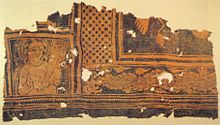Batik (/ˈbætɪk/ or /bəˈtiːk/; Javanese pronunciation: [ˈbateʔ]; Indonesian: [ˈbatɪk]) is a cloth that is traditionally made using a manual wax-resistdyeing technique.
 Javanese traditional batik, especially from Yogyakarta and Surakarta, has notable meanings rooted to the Javanese conceptualization of the universe. Traditional colours include indigo, dark brown, and white, which represent the three major Hindu Gods (Brahmā, Vishnu, and Śiva). This is related to the fact that natural dyes are most commonly available in indigo and brown. Certain patterns can only be worn by nobility; traditionally, wider stripes or wavy lines of greater width indicated higher rank. Consequently, during Javanese ceremonies, one could determine the royal lineage of a person by the cloth he or she was wearing.
Javanese traditional batik, especially from Yogyakarta and Surakarta, has notable meanings rooted to the Javanese conceptualization of the universe. Traditional colours include indigo, dark brown, and white, which represent the three major Hindu Gods (Brahmā, Vishnu, and Śiva). This is related to the fact that natural dyes are most commonly available in indigo and brown. Certain patterns can only be worn by nobility; traditionally, wider stripes or wavy lines of greater width indicated higher rank. Consequently, during Javanese ceremonies, one could determine the royal lineage of a person by the cloth he or she was wearing.
Other regions of Indonesia have their own unique patterns that normally take themes from everyday lives, incorporating patterns such as flowers, nature, animals, folklore or people. The colours of pesisir batik, from the coastal cities of northern Java, is especially vibrant, and it absorbs influence from the Javanese, Arab, Chinese and Dutch cultures. In the colonial times pesisir batik was a favourite of thePeranakan Chinese, Dutch and Eurasians.
UNESCO designated Indonesian batik as a Masterpiece of Oral and Intangible Heritage of Humanity on October 2, 2009. As part of the acknowledgment, UNESCO insisted that Indonesia preserve their heritage.
Etymology
Although the word's origin is Javanese, its etymology may be either from the Javanese amba ('to write') and titik ('dot' or 'point'), or constructed from a hypothetical Proto-Austronesian root *beCík, meaning 'to tattoo' from the use of a needle in the process. The word is first recorded in English in the Encyclopædia Britannica of 1880, in which it is spelled battik. It is attested in the Indonesian Archipelago during the Dutch colonial period in various forms: mbatek, mbatik, batek and batik.
History
Wax resist dyeing technique in fabric is an ancient art form. Discoveries show it already existed in Egypt in the 4th century BCE, where it was used to wrap mummies; linen was soaked in wax, and scratched using a sharp tool. In Asia, the technique was practised in China during the T'ang dynasty (618-907 CE), and in India and Japan during the Nara period (645-794 CE). In Africa it was originally practised by the Yoruba tribe in Nigeria, Soninkeand Wolof in Senegal.
In Java, Indonesia, batik predates written records. G. P. Rouffaer argues that the technique might have been introduced during the 6th or 7th century from India or Sri Lanka. On the other hand, JLA. Brandes (a Dutch archeologist) and F.A. Sutjipto (an Indonesian archeologist) believe Indonesian batik is a native tradition, regions such as Toraja, Flores, Halmahera, and Papua, which were not directly influenced by Hinduism and have an old age tradition of batik making.
Rouffaer also reported that the gringsing pattern was already known by the 12th century in Kediri, East Java. He concluded that such a delicate pattern could only be created by means of the canting (also spelled tjanting or tjunting; pronounced [ˌtʃanˈtiŋ]) tool. He proposed that the canting was invented in Java around that time. The carving details of clothes wore by Prajnaparamita, the statue of buddhist goddess of transcendental wisdom from East Java circa 13th century CE. The clothes details shows intricate floral pattern similar to today traditional Javanese batik. This suggested intricate batik fabric pattern applied by canting already existed in 13th century Java or even earlier.
In Europe, the technique is described for the first time in the History of Java, published in London in 1817 by Sir Thomas Stamford Raffles who had been a British governor for the island. In 1873 the Dutch merchant Van Rijckevorsel gave the pieces he collected during a trip to Indonesia to the ethnographic museum in Rotterdam. Today Tropenmuseum houses the biggest collection of Indonesian batik in the Netherlands. The Dutch were active in developing batik in the colonial era, they introduced new innovations and prints. And it was indeed starting from the early 19th century that the art of batik really grew finer and reached its golden period. Exposed to the Exposition Universelle at Paris in 1900, the Indonesian batik impressed the public and the artisans. After the independence of Indonesia and the decline of the Dutch textile industry, the Dutch batik production was lost. TheGemeentemuseum, Den Haag contains artifacts from that era.
Due to globalization and industrialization, which introduced automated techniques, new breeds of batik, known as batik cap ([ˈtʃap]) and batik print emerged, and the traditional batik, which incorporates the hand written wax-resist dyeing technique is known now as batik tulis (lit: 'Written Batik').
At the same time, according to the Museum of Cultural History of Oslo, Indonesian immigrants to Malaysia brought the art with them. As late as the 1920s Javanese batik makers introduced the use of wax and copper blocks on Malaysia's east coast. The production of hand drawn batik in Malaysia is of recent date and is related to the Javanese batik tulis.
In Sub Sahara Africa, Javanese batik was introduced in the 19th century by Dutch and English traders. The local people there adapted the Javanese batik, making larger motifs, thicker lines and more colors. In the 1970s, batik was introduced to the aboriginal community in Australia, the aboriginal community at Erna bella and Utopia now develop it as their own craft.












0 comments:
Post a Comment